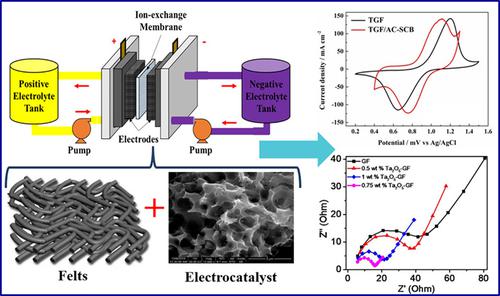当前位置:
X-MOL 学术
›
WIREs Energy Environ.
›
论文详情
Our official English website, www.x-mol.net, welcomes your
feedback! (Note: you will need to create a separate account there.)
Recent progress on carbon and metal based electrocatalysts for vanadium redox flow battery
Wiley Interdisciplinary Reviews: Energy and Environment ( IF 5.4 ) Pub Date : 2020-12-28 , DOI: 10.1002/wene.393 Manoj K. Singh 1 , Manshu Kapoor 2 , Anil Verma 2
Wiley Interdisciplinary Reviews: Energy and Environment ( IF 5.4 ) Pub Date : 2020-12-28 , DOI: 10.1002/wene.393 Manoj K. Singh 1 , Manshu Kapoor 2 , Anil Verma 2
Affiliation

|
Attractive features of vanadium redox flow battery (VRFB) such as long durability, easy scalability, and low levelized cost of energy have influenced its prominence in the sectors where renewable energy is to be stored at a large scale. However, viability of VRFB to be used for a wide‐range of applications such as household electrification, electric vehicle charging infrastructure, and so on has been limited by its low power density. In principle, the power density of VRFB is dependent upon rate of electrochemical reaction on the electrode. The electrochemical properties of the electrode can be improved either by pretreatment of the electrode or by depositing electrocatalyst on the electrode. The use of electrocatalyst helps to lower overpotential losses and reduces the charge‐transfer resistance, which results the VRFB to operate at higher current densities. This review discusses the development and progress of carbon and metal‐based electrocatalyst that have been used for VRFB applications.
中文翻译:

钒氧化还原液流电池用碳和金属基电催化剂的最新进展
钒氧化还原液流电池(VRFB)的吸引人的特性,例如,长寿命,易扩展性和较低的能源成本,已经影响了它在可再生能源大规模存储领域中的突出地位。但是,VRFB的低功率密度限制了其在家庭电气化,电动汽车充电基础设施等广泛应用中的可行性。原则上,VRFB的功率密度取决于电极上的电化学反应速率。可以通过电极的预处理或通过在电极上沉积电催化剂来改善电极的电化学性能。使用电催化剂有助于降低过电势损失并降低电荷转移电阻,这导致VRFB在更高的电流密度下工作。这篇评论讨论了用于VRFB应用的碳和金属基电催化剂的发展和进展。
更新日期:2020-12-28
中文翻译:

钒氧化还原液流电池用碳和金属基电催化剂的最新进展
钒氧化还原液流电池(VRFB)的吸引人的特性,例如,长寿命,易扩展性和较低的能源成本,已经影响了它在可再生能源大规模存储领域中的突出地位。但是,VRFB的低功率密度限制了其在家庭电气化,电动汽车充电基础设施等广泛应用中的可行性。原则上,VRFB的功率密度取决于电极上的电化学反应速率。可以通过电极的预处理或通过在电极上沉积电催化剂来改善电极的电化学性能。使用电催化剂有助于降低过电势损失并降低电荷转移电阻,这导致VRFB在更高的电流密度下工作。这篇评论讨论了用于VRFB应用的碳和金属基电催化剂的发展和进展。











































 京公网安备 11010802027423号
京公网安备 11010802027423号